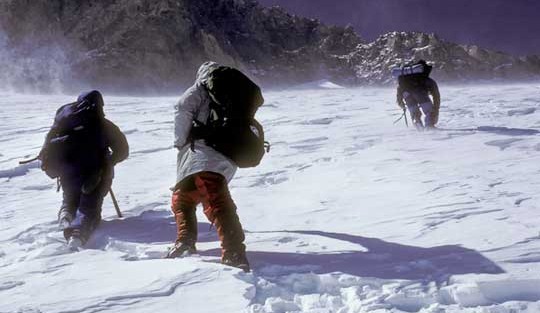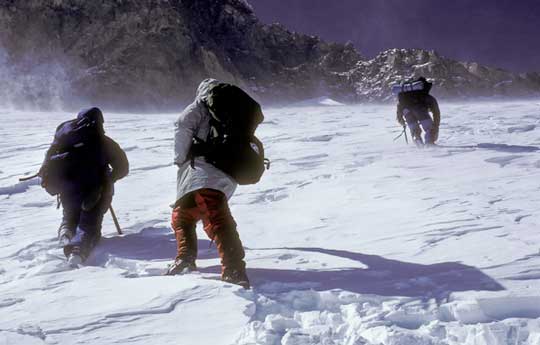

Aconcagua Looms
At 22,834 feet above sea level, Aconcagua looms as the highest peak in the Americas. It lies in Argentina, roughly midway between that country’s wine center of Mendoza and the Chilean capital of Santiago.
By its easiest route, the climb is not technically demanding, but the twin jabs of altitude and weather have knocked out many who have attempted its summit.
The Journey Begins
My visit to the nearby climber’s cemetery provides a sobering reminder that the Grim Reaper works overtime up high.
Aconcagua rises from the treeless Andes on the east side of the international border. A broad ridge and a sheer face separate its twin summits. Unlike many of the world’s high peaks, this one contains only a few small glaciers.
Otherwise, Aconcagua’s crumbling pile of rock and ridges earns it the reputation of being world’s highest rubble heap.
Horse packers haul our gear to the mountain basecamp at 14,000 feet, a two-day hike away. From there, time passes in a mountain climber’s tedium. One day, we lug loads up to the next campsite.
The following morning, we ferry up the rest of our gear. Then we rest. The repetitious pattern gains us a couple thousand vertical feet every three days.
Eventually, we reach a large, flat site at 19,000 feet on Aconcagua’s northwest ridge. After establishing camp, we choke down a pasty dinner and set alarms for a predawn wake up. Tomorrow will be summit day.
The beeping alarm shatters a groggy sleep. Creeping from my sleeping bag, I gaze into frigid darkness. The air blows breezy and stars salt an inky-black sky. It looks to be an ideal day to scale Aconcagua.
Our ascent, which begins in near total darkness, follows a distinct pathway that twists up the loose scree slopes. The sun eventually grazes Andean summits to the north, but the trail keeps us in the cold shadows.
Independencia Hut
By the time we reach the battered remains of Independencia Hut at 21,000 feet, I feel as exhausted as a marathoner at the finish line. Only here, there’s no T-shirt and Gatorade, and I still have half the mountain to go.
After a brief rest, we climb a steep snow bank and march into the direct blast of unabated wind. The trail leads us across a portion of the mountain called the Gran Acarreo, a smooth scree slope 1,500 feet below the summit.
Explosive gusts stop me in my tracks. Wind-propelled ice crystals pelt my face. A ski-mask balaclava gives some protection, but if I cover my nose and mouth I can’t breathe.
“Yes,” I keep mumbling to myself. “This is what I do for fun.”
My mind drifts to more pleasant times. I think about home and family. I hunger for a steak, salad and a hot shower. I long to share warmth and wine with my wife.
I vow that next year’s vacation will involve palm trees and sand, not ice and snow. Then, like a locked up computer, my consciousness goes blank.
At the end of the Gran Acarreo, we turn into the mouth of a talus- and scree-filled gully where the trail abruptly ends.
At 22,000 feet above sea level, we will have to scramble up a rocky slope greased by four inches of powder snow. The plodding becomes painful.
If a plane lost air pressure at this altitude, oxygen masks would drop from overhead compartments. We have to breathe on our own. With every step upward, I stop and gasp for air.
Then I take another step and repeat the process. Boulders and outcroppings only yards away become distant goals taking minutes to reach.
A functioning brain would ask, “Why am I doing this?” Mine never inquires. I just numbly toil on.
We reach the saddle at the top of the gully. Ahead, the mountain plunges in a two-mile drop of rock and ice.
To the right, along a knife-edge ridge, stands the lower south summit. The true top of Aconcagua rises to the left, perhaps a hundred yards beyond.
One of Us Got Sick
One of our party, devoured by fatigue, elects to go no farther. While he waits, the rest of us lumber over boulders along a snow-covered ridge. Finally, we reach a flat piece of ground.
There is no more up to be found. We stand atop the highest point of land in both the Southern and Western Hemispheres.
The mountain’s face drops away. In every direction lies a montage of snow-dappled peaks and ridges separated by dusty green-tinted valleys. These are views reserved for climbers and condors.
For years, I’ve longed to reach this summit. I acquired skills, trained hard, bought equipment and paid a bundle in air fares, and trip fees. I’ve slept in cramped tents, ate marginal food and went weeks without bathing.
Finally, I did it
Finally, it’s all paid off. Here I stand on the top of Aconcagua – my personal Super Bowl, Stanley Cup or Big Enchilada. I should be hoisting my ice-axe in triumph.
But, something is missing.
On lesser peaks, I’ve experienced euphoria, but not here. I feel no elation. No jubilation. No happiness. Nothing.
Rarefied air and physical exhaustion have combined to dull any realization of achievement. I sense only the relief that there was no more uphill.
After five minutes on the summit, we start back down. The reality of the accomplishment will come days later when I look back at the peak and realize I’ve made it.
Yes, this is what I do for fun.
Who should go
Aconcagua is no place for a rookie. Those attempting the peak should have a record of successful climbs at higher altitudes. No one wants suddenly to discover high that he/she is prone toward altitude sickness.
Climbers must have the strength and endurance to lug heavy loads up continuously steep hills.
Although the peak can be technically undemanding, participants should be adept at basic mountaineering skills, especially early in the season when snow still covers the slopes.
Trips
American Alpine Institute (www.aai.cc), Mountain Madness (www.mountainmadness.com), Rainier Mountaineering (www.rmiguides.com) and others offer professionally guided climbs.
Only experienced climbers should attempt to do the climb privately. Check the Aconcagua Web site (www.aconcagua.org) for permit and registration information.
About the Author: Dan Leeth is a freelance writer/photographer who has visited, photographed and written about adventures on all seven continents. To read more of his work, visit www.LookingForTheWorld.com.
- Life of a Champion: Exploring the Muhammad Ali Center in Louisville - April 19, 2024
- What It’s Like to Live as an Expat: Lake Chapala, Mexico - April 18, 2024
- Top 5 Spots for Stargazing in North Carolina - April 17, 2024
